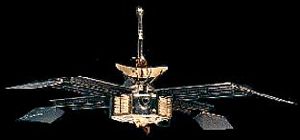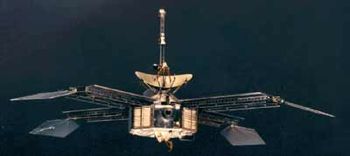
Home - Search - Browse - Alphabetic Index: 0- 1- 2- 3- 4- 5- 6- 7- 8- 9
A- B- C- D- E- F- G- H- I- J- K- L- M- N- O- P- Q- R- S- T- U- V- W- X- Y- Z
Mariner 3-4
 Mariner 3, 4 Credit: NASA |
Status: Operational 1964. First Launch: 1964-11-05. Last Launch: 1964-11-28. Number: 2 . Gross mass: 260 kg (570 lb).
It was designed to conduct closeup scientific observations of Mars and to transmit these observations to earth. Other mission objectives were to perform field and particle measurements in interplanetary space in the vicinity of Mars and to provide experience in and knowledge of the engineering capabilities for interplanetary flights of long duration.
The spacecraft was 3-axis stabilized using cold gas thrusters. Four deployed solar panels were kept oriented toward the Sun. S-Band communications used either the low gain or high gain antennas. The spacecraft consisted of an octagonal magnesium frame, 127 cm across diagonally and 45.7 cm high. Four solar panels were attached to the top of the frame with an end-to-end span of 688 cm, including solar pressure vanes which extended from the ends. A 116.8 cm diameter high gain parabolic antenna was mounted at the top of the frame as well. An omnidirectional low gain antenna was mounted on a 223.5 cm tall mast next to the high gain antenna. The overall height of the spacecraft was 289 cm. At the bottom center of the spacecraft the television camera was mounted on a scan platform. The octagonal frame housed the electronic equipment, cabling, midcourse propulsion system, and attitude control gas supplies and regulators.
Power was supplied by 28,224 solar cells contained in the four 176 x 90 cm solar panels, which provided 310 W at Mars. A rechargeable 1200 W-hr silver-zinc battery was also used for maneuvers and backup. Monopropellant hydrazine was used for propulsion, via a 4-jet vane vector control 222-N motor installed on one of the sides of the octagonal structure. Attitude control was provided by 12 cold nitrogen gas jets mounted on the ends of the solar panels and three gyros. Solar pressure vanes, each with an area of 0.65 square meters, were attached to the tips of the solar panels. Positional information was provided by four Sun sensors, and an Earth, a Mars, and a Canopus sensor.
Telecommunications equipment consisted of a dual, S-band 7-W triode cavity amp/10-W TWTA transmitter and a single receiver which could send and receive data via the low- and high-gain antennas at 8 1/3 or 33 1/3 bps. Data could also be stored on a tape recorder with a capacity of 5.24 million bits for later transmission. All operations were controlled by a command subsystem which could process any of 29 direct command words or 3 quantitative word commands for midcourse maneuvers. The central computer and sequencer operated stored time-sequence commands using a 38.4 kHz synchronization frequency as a time reference. Temperature control was achieved through the use of adjustable louvers mounted on six of the electronics assemblies, multilayer insulating blankets, polished aluminum shields, and surface treatments.
Most of the science experiments were mounted on the outside of the frame. Science instruments, in addition to the TV camera, were a magnetometer, dust detector, cosmic ray telescope, trapped radiation detector, solar plasma probe, and ionization chamber/Geiger counter. The tape recorder stored 21 pictures.
More at: Mariner 3-4.
Family: Mars flyby. Country: USA. Launch Vehicles: Atlas, Mars tactical rocket, Atlas Agena D. Projects: Mariner, Mars. Launch Sites: Cape Canaveral, Cape Canaveral LC12, Cape Canaveral LC13. Agency: JPL, NASA. Bibliography: 2, 278, 296, 3874, 3876, 3877, 3878, 3879, 3880, 3881, 3882, 3885, 3886, 3892, 3893, 3898, 3899, 3904, 3906, 6, 12794.
 | Mariner 3 Credit: Manufacturer Image |
1964 November 5 - . 19:22 GMT - . Launch Site: Cape Canaveral. Launch Complex: Cape Canaveral LC13. LV Family: Atlas. Launch Vehicle: Atlas Agena D. FAILURE: Launch fairing failure. Failed Stage: S.
- Mariner 3 - . Payload: Mariner C-2. Mass: 260 kg (570 lb). Nation: USA. Agency: JPL, NASA. Program: Mariner. Class: Mars. Type: Mars probe. Spacecraft Bus: Mariner. Spacecraft: Mariner 3-4. USAF Sat Cat: 923 . COSPAR: 1964-073A. Mars probe; launch fairing failure prevented Mars flyby. Solar Orbit (Heliocentric). Spacecraft engaged in research and exploration of the upper atmosphere or outer space (US Cat B)..
1964 November 28 - . 14:22 GMT - . Launch Site: Cape Canaveral. Launch Complex: Cape Canaveral LC12. LV Family: Atlas. Launch Vehicle: Atlas Agena D.
- Mariner 4 - .
Payload: Mariner C-3. Mass: 260 kg (570 lb). Nation: USA.
Agency: JPL,
NASA.
Program: Mariner.
Class: Mars.
Type: Mars probe. Spacecraft Bus: Mariner.
Spacecraft: Mariner 3-4.
USAF Sat Cat: 938 . COSPAR: 1964-077A.
Mariner 4 provided the first up close pictures of Mars. The protective shroud covering Mariner 4 was jettisoned and the Agena D/Mariner 4 combination separated from the Atlas D booster at 14:27:23 GMT on 28 November 1964. The Agena D first burn from 14:28:14 to 14:30:38 put the spacecraft into an Earth parking orbit and the second burn from 15:02:53 to 15:04:28 injected the craft into a Mars transfer orbit. Mariner 4 separated from the Agena D at 15:07:09 and began cruise mode operations. The solar panels deployed and the scan platform was unlatched at 15:15:00 and Sun acquisition occurred 16 minutes later. A midcourse maneuver made on 5 December 1964.
After a 228 day cruise, the spacecraft flew by Mars on July 14 and 15, 1965. Planetary science mode was turned on at 15:41:49 GMT on 14 July. The camera sequence started at 00:18:36 GMT on July 15 and 21 pictures plus 21 lines of a 22nd picture were taken. The images covered a discontinuous swath of Mars starting near 40 N, 170 E, down to about 35 S, 200 E, and then across to the terminator at 50 S, 255 E, representing about 1% of the planet's surface. The closest approach was 9,846 km from the Martian surface at 01:00:57 GMT 15 July 1965. The images taken during the flyby were stored in the onboard tape recorder. At 02:19:11 GMT Mariner 4 passed behind Mars as seen from Earth and the radio signal ceased. The signal was reacquired at 03:13:04 GMT when the spacecraft reappeared. Cruise mode was then re-established. Transmission of the taped images to Earth began about 8.5 hours after signal reacquisition and continued until 3 August. All images were transmitted twice to insure no data was missing or corrupt.
The spacecraft performed all programmed activities successfully and returned useful data from launch until 22:05:07 GMT on 1 October 1965, when the distance from Earth (309.2 million km) and the antenna orientation temporarily halted signal acquisition. In 1967 Mariner 4 returned to the vicinity of Earth again and engineers decided to use the ageing craft for a series of operational and telemetry tests to improve their knowledge of the technologies that would be needed for future interplanetary spacecraft. The cosmic dust detector registered 17 hits in a 15 minute span on 15 September, part of an apparent micrometeoroid shower which temporarily changed the spacecraft attitude and probably slightly damaged the thermal shield. On 7 December the gas supply in the attitude control system was exhausted, and on December 10 and 11 a total of 83 micrometeoroid hits were recorded which caused perturbation of the attitude and degradation of the signal strength. On 21 December 1967 communications with Mariner 4 were terminated.
Results
The total data returned by the mission was 5.2 million bits. All experiments operated successfully with the exception of the ionization chamber/Geiger counter which failed in February, 1965 and the plasma probe, which had its performance degraded by a resistor failure on 6 December 1964. The images returned showed a Moon-like cratered terrain (which later missions showed was not typical for Mars, but only for the more ancient region imaged by Mariner 4). A surface atmospheric pressure of 4.1 to 7.0 mb was estimated and no magnetic field was detected.
1965 July 14 - .
- Mariner 4, Mars Flyby - . Nation: USA. Spacecraft Bus: Mariner. Spacecraft: Mariner 3-4.
Back to top of page
Home - Search - Browse - Alphabetic Index: 0- 1- 2- 3- 4- 5- 6- 7- 8- 9
A- B- C- D- E- F- G- H- I- J- K- L- M- N- O- P- Q- R- S- T- U- V- W- X- Y- Z
© 1997-2019 Mark Wade - Contact
© / Conditions for Use